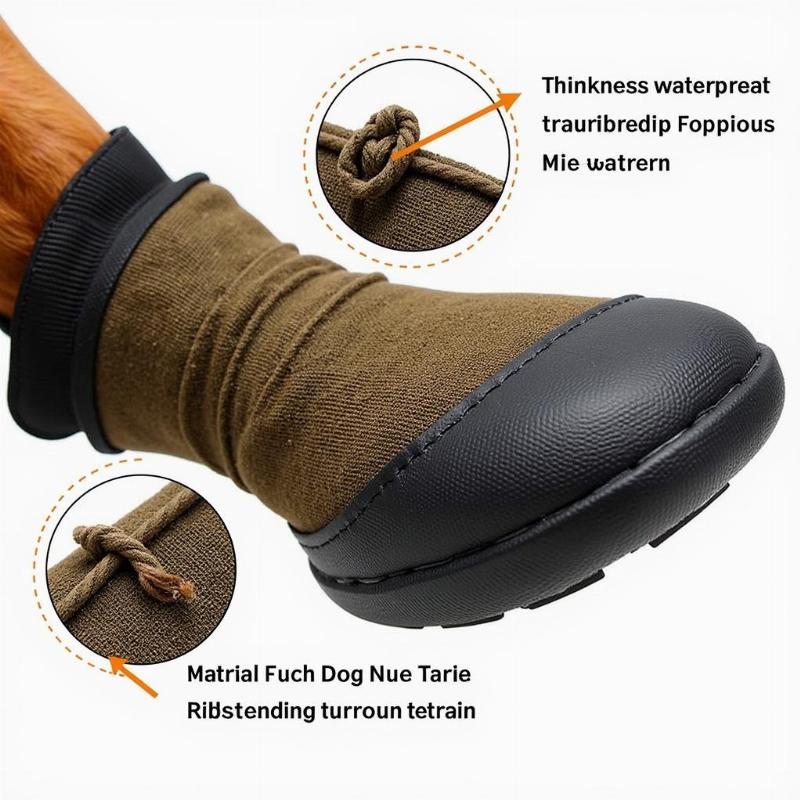Finding the right dog boots for your extra large canine companion can be a challenge. With so many options on the market, it’s important to understand what features to look for to ensure a comfortable and secure fit for your gentle giant. This comprehensive guide will cover everything you need to know about selecting, using, and caring for dog boots designed specifically for extra large dog breeds.
Why Your Extra Large Dog Needs Boots
Large breed dogs, especially those spending time outdoors, can benefit significantly from wearing boots. Protecting their paws from extreme temperatures, rough terrain, and harmful chemicals is crucial for their overall health and well-being. Think of it like wearing shoes yourself – you wouldn’t want to walk on hot pavement or through thorny bushes barefoot! Dog boots offer the same protection for your furry friend.
Choosing the Right Size and Fit
Proper fit is essential for your dog’s comfort and to prevent the boots from slipping off. Many brands offer size charts specific to extra large breeds. how to measure dog paws for boots It’s crucial to measure your dog’s paw width and length accurately and consult these charts. Look for boots with adjustable straps or closures for a secure and customized fit. Boots that are too tight can restrict circulation, while boots that are too loose can cause chafing and discomfort.
How do I know if the boots fit my extra large dog correctly?
A well-fitting boot should allow your dog to walk comfortably without limping or showing signs of discomfort. You should be able to slip two fingers between the boot and your dog’s paw. Observe your dog’s gait after putting on the boots to ensure they are not causing any issues.
Materials and Durability
Dog boots for extra large breeds need to be made from durable, high-quality materials to withstand the wear and tear of active dogs. Look for boots made from tough, waterproof materials like rubber or nylon.  Durable material of dog boots Consider the terrain your dog typically walks on. If you frequently hike on rocky trails, you’ll need boots with a rugged sole. For city walks, a lighter-weight boot might be sufficient.
Durable material of dog boots Consider the terrain your dog typically walks on. If you frequently hike on rocky trails, you’ll need boots with a rugged sole. For city walks, a lighter-weight boot might be sufficient.
Key Features for Extra Large Dog Boots
Certain features are particularly important for boots designed for larger dogs. These include:
- Non-slip soles: Extra large dogs can be prone to slipping, especially on smooth surfaces. Non-slip soles provide added traction and stability.
- Secure closures: Look for boots with reliable straps, buckles, or Velcro closures to prevent the boots from coming off during walks or playtime.
- Breathability: To avoid overheating and discomfort, choose boots made from breathable materials. Mesh panels or ventilation holes can help keep your dog’s paws cool and dry.
- Reflective elements: For enhanced visibility during nighttime walks, consider boots with reflective strips or accents.
Getting Your Dog Used to Wearing Boots
Introducing boots to your dog gradually is crucial. Start by letting your dog sniff and explore the boots. Reward them with treats and praise. dog slipping on wooden floor Gradually increase the wearing time, starting with short periods indoors and then progressing to outdoor walks. Be patient and encouraging, and your dog will soon associate the boots with positive experiences.
Caring for Dog Boots
Proper care and maintenance can extend the lifespan of your dog boots. Most boots can be cleaned with mild soap and water. Allow them to air dry completely before storing them. Regularly inspect the boots for any signs of wear and tear, and replace them when necessary.
Conclusion
Investing in a good pair of dog boots for your extra large dog is an investment in their health and happiness. By following the guidelines outlined in this guide, you can find the perfect boots to provide comfort and protection for your beloved companion. Remember to consider your dog’s individual needs and activity level when making your selection.
FAQ
- How often should I replace my dog’s boots? This depends on how frequently they are worn and the terrain they are used on. Inspect them regularly and replace them when they show signs of wear and tear.
- My dog keeps chewing on his boots. What can I do? Try using a bitter apple spray on the boots to deter chewing. You can also distract your dog with chew toys while they are wearing the boots.
- Can my dog swim in his boots? While some boots are water-resistant, most are not designed for swimming. Remove the boots before allowing your dog to swim.
- Are dog boots necessary for all extra large breeds? While not strictly necessary, they offer valuable protection and can be especially beneficial for dogs with sensitive paws or those living in harsh climates.
- What if my dog has allergies? Look for boots made from hypoallergenic materials.
- Can I use human boots on my dog? No, human boots are not designed for a dog’s paw anatomy and can cause discomfort and even injury.
- Where can I buy dog boots for extra large dogs? Pet stores, online retailers, and some veterinary clinics carry dog boots.
Related Articles
Beautdogs.us is your premier online destination for all things dog-related in the US. We offer expert advice on dog breeds, care, and lifestyle, catering to both new and experienced dog owners. Our team of Certified Pet Professionals and Content Strategists are dedicated to providing you with reliable and engaging information. Explore our website for comprehensive guides on dog health, training, and product recommendations. Contact us for personalized advice at [email protected] or +1 501-555-7529. Visit Beautdogs.us for all your dog’s needs!